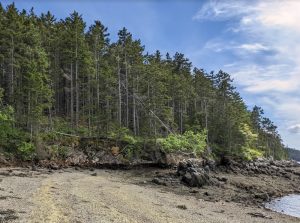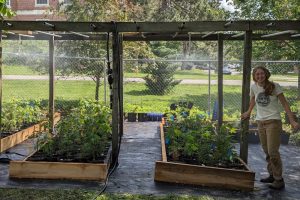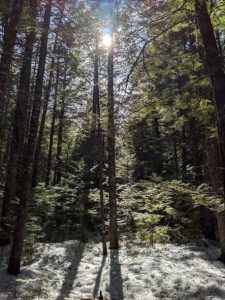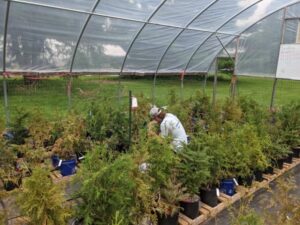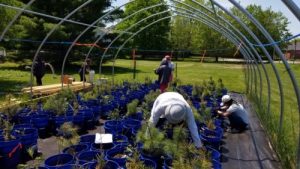Jay Wason – Research
As the climate continues to rapidly warm, most tree species will not be able to migrate rapidly enough to follow their suitable climates. Therefore, many trees are being left behind experiencing novel climate conditions. However, it is unclear how much climate change many species can tolerate. We are studying physiological adaptations of trees to determine how they will respond to these novel climate conditions including changes in growth, photosynthesis, resource allocation, and survival.
Management and Conservation of Coastal Spruce Forests for Resilience to Rapid Warming
The overall objective of this USDA funded project is to identify the factors that promote coastal red spruce forests, assess the risks posed by climate change, and develop tools to manage for resilience. Our central hypothesis is that rapid climate warming makes coastal red spruce ecosystems extremely vulnerable to climate change due to the species’ requirement for cool moist conditions, low tree species diversity, and the ecosystem’s
limited active management. We will achieve this objective by 1) identifying the factors driving recent and current trends in coastal spruce distributions, 2) quantifying coastal spruce forest dynamics and sensitivity to climate stressors, and 3) identifying how climate reduces spruce germination, establishment, growth, and survival.
Impacts of extreme climate events on tree regeneration in the Northern Forest
The goal of this Northeastern States Research Cooperative funded project is to determine how tree regeneration in the Northern Forest will respond to extreme drought, heat, and midwinter warming events in order to provide forest managers needed information to prepare for the future. Objective 1: Determine how growth, physiology, and survival of saplings of ten tree species are impacted by extreme drought and a summer heat wave. Objective 2: Identify the phenological sensitivity of ten tree species to midwinter warming events and the risks associated with subsequent re-freezing. Learn more here!
Responses of new species assemblages to heat and drought stress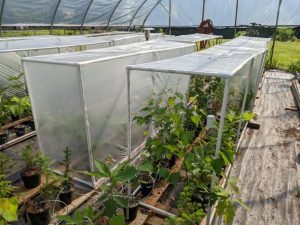
Climate change is expected to shift the ranges of tree species leading to new interactions as trees migrate into different forest types. Climate change is also expected to lead to an increase in the likelihood of extreme heat and drought stress such as the severe and extreme droughts that developed in parts of New England in 2022. In a series of experimental studies, we are testing how tree regeneration responds to extreme heat and drought and the effect of new competitors on those responses.
Effects of forest structure on understory microclimate
Localized climate conditions (microclimates) are key for determining how climate change will impact tree regeneration. In forests, the structure and composition of the overstory, is a major determinant of the understory microclimate. For example, dense overstory conditions can buffer sensitive seedlings from extremes of both heat and cold. Whereas more open conditions can expose seedlings to extreme microclimates that may drive mortality. In this study, we are examining how climate change may interact with variation in canopy structure and composition in both managed and unmanaged stands to impact the buffering of extreme microclimates.
Precipitation extremes and tree physiology
In many lowland forests of Maine, northern white cedar (Thuja occidentalis) is being outcompeted by balsam fir (Abies balsamea). However, as climate changes, it is unclear how extreme events may differentially impact these species and change their competitive dynamics. In this study, we are testing how physiology, growth, and survival of cedar and fir respond to extreme flood and drought conditions.
Thinning effects on climate-growth relationships in spruce-fir forests

Thinning forests by removing trees can reduce competition for resources. This research aims to determine how thinning timing and intensity impact the relationship between climate and tree growth in managed spruce-fir forests across Maine.
DroughtTIME: Drought Timing Impacts in Maine
Dry growing seasons are expected to become more common in the future with negative consequences for trees. The timing of droughts (spring, early summer, late summer) can impact how trees respond both within that year and the legacy of effects in subsequent years. We planted 288 trees of six species in a controlled experiment to track physiological responses to experimentally imposed droughts during different times of year.
Regeneration strategies of Northern White Cedar
Northern white cedar (Thuja occidentalis) is a species of ecological, economic, and cultural value however many northern white cedar stands suffer from low regeneration and recruitment. Our lab is collaborating with other scientists at the School of Forest Resources to test different modes of northern white cedar regeneration so we can better understand population demographics and inform management strategies.
Structure and function of 3D xylem networks in trees
Trees transport water through a series of interconnected conduits collectively known as xylem. As the climate continues to warm, droughts are expected to have a large impact on tree species world-wide. In most cases, however, it remains unclear if and how trees can modify their xylem networks in response to drought. As a postdoctoral associate, I worked with Craig Brodersen and Brett Huggett to study how four dominant trees in the northeastern
United States can modify the structure of their xylem networks in response to drought conditions. Most of our research was conducted at Harvard Forest, MA. We have also been developing a set of 3D-printable models that can be used to teach plant xylem anatomy. Check out the 3D data portal here.
Here is an example 3D model of a tree core collected from a white ash tree. The large “tubes” are xylem vessels that transport water vertically in the tree and are approximately the diameter of a human hair in reality. Each row of vessels represents a different growth ring with larger earlywood vessels formed in the spring tapering to smaller latewood vessels that formed later in the summer.
Environmental drivers of forest tree species growth and distributions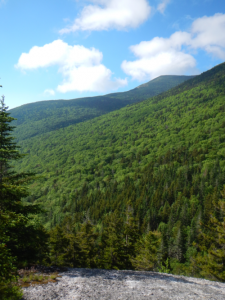
In the northeastern United States, spruce-fir forests typically occupy elevations greater than ~750 m above sea level and are expected to shift to higher elevations with climate change. At SUNY-ESF, I studied how spruce-fir forest distributions and growth rates have responded to recent changes in climate and how those responses can be modified by other environmental factors such as acid rain, land-use legacies, and soils. We measured vegetation, climate, and tree growth on 12 mountains across the northeastern US. This survey included mountains in the Adirondacks (NY), Green Mountains (VT), White Mountains (NH and ME) among others to help build a comprehensive picture of the health of northeastern mountain forests and provide insight into their future conservation.


